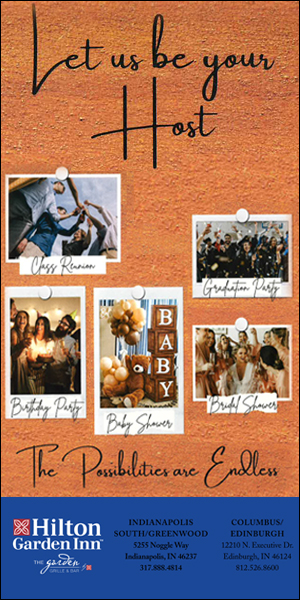
From a diverse topography to talent, Indiana can hold its own, given the chance
By Kaylin Brian // Photography submitted
Hoosier filmmaker Thomas DeCarlo has an extensive resume: writer, director, producer and self-taught CGI animator. He is a pioneer, to be sure: He is currently producing what he believes to be the first feature-length animated film to come out of Indiana. The film is being adapted from his award-winning animated short, “The Encounter,” from his own studio, DeCarlo Animation. What’s more, he’s employing a remarkably small team to create it.
“The smallest computer-animated films being made in the U.S. start around $20 million and have over a hundred people on their crew,” he says. “We’re doing it under a million and have 10 people on our crew.” When it’s done, he hopes to have carved out a niche for it in Indiana.
“People will tell me, ‘I’ve never thought of Indiana as animation,’” he says.
While it may not be known for its animated productions, Indiana has served as the official setting and/or location of a diverse catalog of films, including “Rudy,” “A League of Their Own” and — perhaps most well-known — “Hoosiers.” These are the movies most of us can name during a round of pub trivia, but DeCarlo is proof that smaller, indie productions can hold their own in the Hoosier state.
Amy Howell, director of Film Indiana, offers more proof. “Lots of smaller productions and independent films are happening every day across Indiana. The NFL Network, ‘Restaurant Impossible,’ ‘Lakefront Bargain Hunters,’ ‘Ghost Hunters,’ to name a few, filmed in Indiana in 2019. Over 600 requests for information came in to Film Indiana,” Howell says. “The number continues to grow each year.”
Money talks, productions walk
Although Indiana offers a diverse landscape that could accommodate any filmmaker, it does face a big hurdle in the filmmaking industry: a lack of tax incentive. Indiana is one of 17 states that doesn’t offer a tax incentive for film production.
What does that mean? In short, a tax incentive for filmmaking means that a state will give you 30 cents back for every dollar spent on production, which in turn stimulates the local community and creates sustainable jobs. But John Armstrong gets to the heart of it.
“Filmmaking is a trillion-dollar industry, and Indiana is not getting a piece of it,” Armstrong says.
This a problem that’s near and dear to Armstrong’s heart. He is the co-founder and COO of Indiana-based film production company, Pigasus Pictures. The company is home to films such as “Ms. White Light,” which won Italian Press Best Picture, and “The Good Catholic,” which was filmed in Bloomington and stars Danny Glover and John C. McGinley.
Armstrong began his work as an actor before helping to found Pigasus Pictures, and he has even testified before Congress in support of a tax incentive for filming in Indiana.
The lack of tax incentive is a missed opportunity in several ways. For one, film and TV production is a booming economy that has the potential to create sustainable jobs in Indiana. “It doesn’t require a four-year degree, either,” Armstrong says. “You can get technical training and work as a key grip on set.”
But maybe more importantly, Indiana is not telling its stories. “Indiana has its own character, in the same way that other places in the country have their own character,” he says. “But because we don’t have a robust film/TV industry here, Indiana’s character isn’t depicted accurately.”
And it’s true: There are several films and TV shows set in Indiana, including perennial favorite “A Christmas Story,” comedy hit series “Parks and Recreation” and Netflix’s popular paranormal coming-of-age series, “Stranger Things.”
But these shows and movies aren’t filmed in Indiana. “Other places get to tell their stories and create their identity through film, but Indiana kind of ends up being a punchline sometimes,” Armstrong says.
It’s important to make connections to film, to use them to broadcast our cultural identity. “When we watch films and we see things that resonate with us, we see ourselves reflected, and it makes us feel like we’re not alone,” he says. “Right now, Indiana has no incentive to tell Indiana stories.”
Tax incentives wouldn’t just benefit local filmmakers, either. Howell says the Hoosier state has a lot to offer filmmakers in general. “We have a diverse topography. From the south shoreline of Lake Michigan to the Ohio River, there’s a backdrop for almost every filmmaker’s needs.”
Film Indiana works to amplify those locations. It offers a production directory (featuring crews, production companies, equipment rentals and more), a location directory and job listings, all for free. “Film Indiana’s primary objectives are to promote Indiana assets and destinations to prospective filmmakers and assist companies seeking production services in the state,” Howell says. “Film Indiana is here to help bring your projects to life.”
Filming the gap
A new tool could help show those filmmakers what they’re missing out on. DeCarlo has found a way to put Indiana films on the marquee: streaming. Together with his wife, he launched the streaming service, Hoosier Films, in the fall of 2018. It calls itself “your gateway to independent film in Indiana” and offers a catalog of short and feature-length films across all genres by Hoosier filmmakers.
“I wanted it to be something where you can follow and find in one place just the films that are being made by local filmmakers,” DeCarlo says. The service offers streaming for just $12 a year, and there is also an option to purchase several of the films. Whether you buy a subscription or purchase the films outright, a percentage of the net sales go directly back to the filmmakers.
DeCarlo’s intent is address the gap between Indiana filmmakers and their communities. “There are so many people making cool stuff, and people have no idea it exists,” he says.
In the beginning, the streaming site was supposed to be much more mobile. “We originally launched a mobile cinema, a little indoor theater with 16 theater seats in it,” DeCarlo says. The idea was to give folks an introduction to independent Indiana films by taking the mobile theater to art fairs and street events, but that idea was sidelined for the time being due to COVID-19.
DeCarlo also has plans for a Hoosier Films annual festival that was originally scheduled for March. It boasts a robust lineup of 38 short films and three feature-length films that will bring together people from all over the state to celebrate how much is going on in Indiana filmmaking. “We wanted to make a film festival where every filmmaker who came out could very easily walk away with a new partnership and a new collaboration with someone,” he says.
Like Armstrong, DeCarlo notes that the importance of creating a space for Hoosier filmmakers to collaborate is just as important as connecting those filmmakers to their local communities.
“That’s who’s going to support us the most: people who get to see their community and people they know in films and supporting those local artists,” he says.


